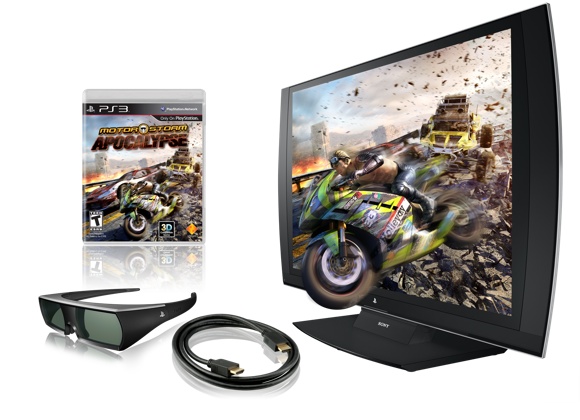I tried it with various Xbox 360 and PlayStation 3 as well as PC games, and—especially at its native 1920 by 1080 resolution—the color depth and visual crispness are unbeatable. I piped the PC version of The Elder Scrolls V: Skyrim in via an HDMI cable at ultra-high detail settings, for instance, and the image easily leapfrogs the one I’m seeing on my dedicated 22-inch PC LCD (also digital). The only caveat, and it’s not the 3D TV’s fault, is that that detail is so fine here that sub-1080p-native games, which have to be upscaled, are more noticeably interpolated. It’s especially hard to look past in 720p games like Uncharted 3, where the edges of objects, say leaves on trees or the outlines of character frames, tend to look stretched, the aliasing more pronounced.
As for the TV’s vaunted 3D features, basic 3D mode works as you’d expect: You have to wear a pair of fugly-looking glasses to make games (and movies) appear 3D, though the glasses are light and comfortable enough, and easily fit over my own pair. They charge off a USB cable, and Sony says three minutes get you three hours play time (or 30 minutes for 30 hours of play). They’re also universal, meaning they’ll work with pretty much any 3D set with infrared emitters.
I tested with The ICO & Shadow of the Colossus Collection, since my review unit didn’t come with MotorStorm Apocalypse, and Uncharted 3’s standard 3D mode isn’t working yet (Sony says a fix is coming in a patch). As claimed, “crosstalk” is all but gone here, so that’s the biggest selling point. And as usual, you’ll have to crank brightness settings—in-game as well as on the set—to bring 3D mode up to acceptable viewing levels.
A secondary lure for those who enjoy hotseat gaming—playing competitively with others in the same room, using one screen—is the PS TV’s “SimulView” mode, which lets two players view unique images simultaneously (you’ll need a second pair of glasses, sold separately for $70). There’s not a lot to say here: It works as you’d expect, two pairs of glasses picking up discrete video feeds and letting two players game in tandem. The chief complaint, which I’ll aim more at videophiles and image purists than casual players, is that you’ll see slight image ghosting—after-images when there’s onscreen motion. Another problem’s the screen’s size: 24 inches is a little small for two-player gaming. We’re also talking just four games that support SimulView at launch: MotorStorm Apocalypse, Gran Turismo 5, Killzone 3 and Super Stardust HD. As a selling point, SimulView isn’t much of one at this point.
There’s no question about the PS TV’s ability to deliver triple-A 1080p video as well as virtually crosstalk-free 3D to a 24-inch LED-backlit screen, and it’s certainly not priced unreasonably at $500. It’s biggest knock is the glare issue, a design choice Sony obviously made to deliver flawless color and contrast levels. If you can see past the reflectivity issue, and you’re looking to leap into the stereoscopic 3D game without dropping a fortune, Sony’s PS TV makes it possible without quality-skimping.
MORE: Hello, 3D PC! HP Unveils TouchSmart 620 All-in-One
Matt Peckham is a reporter at TIME. Find him on Twitter at @mattpeckham or on Facebook. You can also continue the discussion on TIME’s Facebook page and on Twitter at @TIME.


